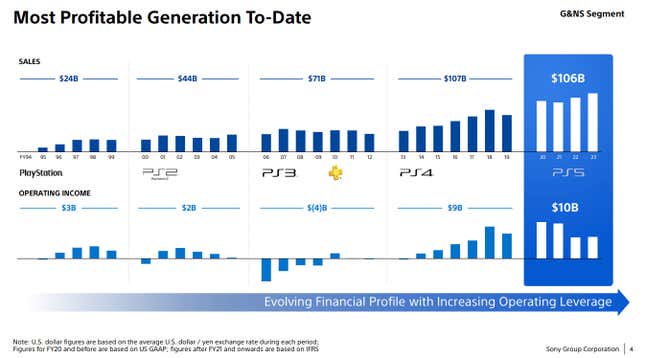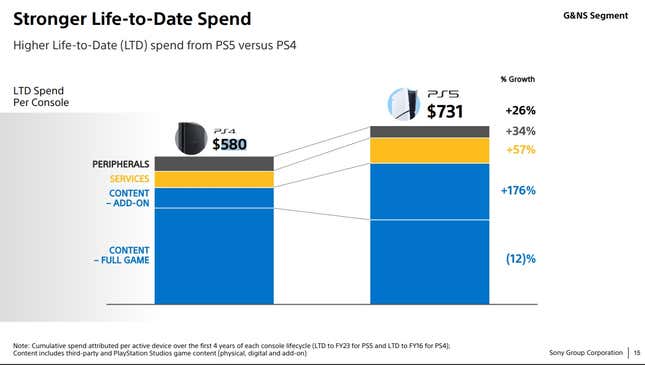Sony recently held a business briefing for investors where it painted an incredibly rosy picture around the PlayStation 5 and its future outlook. Despite recent layoffs and failing to reach its sales goals for 2023, the company seems confident that the console’s best days are still ahead.
A lot of that assessment seems based on the prospects surrounding big games coming in the years ahead, as well as PlayStation’s ability to soak up ever more spending from its most loyal players. The market for PS5s might not be expanding, but the amount of money PS5 owners will pour into the ecosystem certainly seems to be growing.
Here’s a bunch of things we learned from the May 29 presentation by soon-to-be promoted co-CEOs Hermen Hulst and Hideaki Nishino.
PS5 is Sony’s most profitable console generation yet

The PS5 might be trending slightly behind the PS4 in total lifetime sales globally (it’s ahead in the U.S.), but Sony revealed that those who have upgraded are spending a lot. PS5 players have dolled out $731 on average on the new platform, compared to $580 for PS4 players at a similar period in the console cycle. At the halfway point, revenue for the PS5 generation is $106 billion in sales, and $10 billion in operating income (profit), which is roughly the same as what the PS4 achieved in its full seven year life cycle.
That success is due in part to the ongoing popularity of the older console. Roughly half the player base is still on PS4, though PS5 players play almost twice as many hours in aggregate as their last-gen counter-parts. It makes sense that the most loyal players would be the ones to upgrade, but it has certainly eroded the idea of modern console generations being discrete cycles rather than continuations of platform like on PC and smartphones.
PC still won’t get big single-player games day-and-date
While Helldivers 2 is the best-selling game of the year so far thanks to it coming to PS5 and PC simultaneously, Sony doesn’t have plans to start bringing games like Wolverine day-and-date to Steam. That appears to be reserved for live service games like Firewalk Studios’ Concord, expected later this year, and Bungie’s Marathon, slated for release in 2025.
Hulst said that the company will continue taking a “more strategic” approach with its “tentpole titles” by giving PC players a taste of its console exclusive franchises with ports close to when a sequel is about to come out. “We’re finding new audiences that are potentially going to be very interested in playing sequels on the PlayStation platform,” he claimed. That’s hard to believe considering Steam diehards are infamous for waiting years to play new blockbusters instead of buying them on rival storefronts like Epic Games.
Microtransactions are eating into game sales

Total spending might be up on PS5, but a lot of it is going to the same top 10 live service games like Fortnite and Apex Legends. Spending on full games has gone down by 12 percent on PS5 compared to PS4, despite the prices going up to $70. Spending on things like DLC, battle passes, and cosmetics, meanwhile, has rocketed up 176 percent this console generation. It’s not hard to see how this translates into a tougher landscape for new games, or why so many publishers are obsessed with making the next Grand Theft Auto Online or Genshin Impact. First-party Sony games continue to sell well, though: Spider-Man 2 has now sold over 11 million copies.
More PS Plus subscribers are upgrading
PS Plus is more complicated and expensive than ever, but it seems to be working for Sony thus far. Even if overall subscription numbers haven’t dramatically changed, more regular PS Plus subscribers are upgrading to the Extra and Premium tiers. The Extra tier, which includes the free library of games, grew 16 percent last year, and Premium, which includes access to PlayStation Classics and cloud streaming grew 19 percent. It seems to be in keeping with the theme that if you can’t grow the audience, simply upsell them as much as you can before they burnout.
PS VR2 who?

One thing that doesn’t seem to be growing is the market for Sony’s virtual reality headsets. Nobody asked about PS VR2 in the meeting and it is not called out directly anywhere in the presentation. Instead, the VR headsets are rolled into a general category of “peripherals” alongside headphones and PlayStation Portal handhelds.
While player spending on peripherals has grown 34 percent since the PS4 console generation, it still makes up the smallest sliver of the total. Sony hasn’t disclosed how many of the headsets its shipped and has reportedly halted production until it can clear out the existing inventory. VR just doesn’t seem to be a meaningful part of Sony’s roadmap at the moment.
Sony hasn’t given up on mobile
Last year, Sony expected half of its releases in 2025 to be on PC and mobile. So far, it hasn’t shipped any new games on smartphones. They’re coming though as part of a strategy to reach new audiences and use that money to subsidize the investment required to grow core franchises on console. “On mobile we have been hard on at work on establishing a very strong, very seasoned core mobile team,” Hulst said. “We’re taking a more measured approach compared to the more aggressive approach you’ve seen on PC that’s because PC is more adjacent to the core of our development than mobile is.”
Live service gaming is still the goal

At one point, Hust was asked about the status of Bungie, which laid off 100 people last year amid plunging Destiny 2 numbers. He confirmed that the studio wasn’t expected contribute to Sony’s profit this year, in part due to ongoing investment in Marathon. At the same time, he said “significant progress” had been made with the integration into the rest of PlayStation. That sounds terrifying for longtime Bungie fans, but Hulst said the studio had been invaluable with getting the rest of the company up to speed on developing games as a service. He called these “optimizations” to its production pipelines for these types of games the main goal of the acquisition in the first place.
Will it bear fruit? It seems like only about a half of the dozen or so live service projects originally in development at one time or another are still moving forward. Sci-fi shooter Concord is one of those. Fairgame$, Haven’s stab at multiplayer heist genre, is another. Neon Koi, Sony’s mobile game studio, is also listed under the Live Service Focus” section of its presentation. Guerrilla Games, meanwhile, is under the “Evolving / Multi-Genre” section, and we know it’s working on multiplayer spin-offs of Horizon Zero Dawn.
Interestingly, Bend Studio, which made Days Gone, is in the same category, suggesting its next project might have a multiplayer component as well. Whether any of these live service games can supplant the ones already taking up so much of the oxygen on PlayStation remains to be seen. With microtransaction spending growing the most since the PS4 generation, it’s easy to see why Sony wants to try.



